

Katharine
Buildings, Cartwright
Street see also Peabody Estate
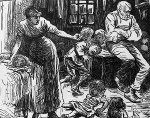

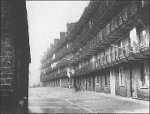 Built
in 1884 and fully opened in June 1885 on a slum clearance site in
Cartwright Street behind the Royal
Mint, opposite Rothschild's Albert Buildings across the street, this was the
first project of the East End
Dwellings Company
(EEDC).
It offered accommodation, in single unconnected rooms with
shared
cooking facilities and sanitation, for casual labourers and the poorer
sections
of the working classes, including day workers at the docks, for whom,
as explained here, the '5%
philanthropists' were unwilling to provide. (For example, in 1888 there
was a Goan Lascar tenant - who would not have qualified for social
housing elsewhere; however, in the early years there were also, for
example, three police families - who would.) This meant that costs were cut, and
sanitary arrangements less good than in other developments (there
were ongoing issues about the siting of lavatories - see below), though
they were certainly better than in the housing they replaced. The contraints of
the site [right on
Goad's 1887 insurance map - marked as 'Artizans Dwellings' - with the
Albert Buildings across the street] meant that the architects, Davis
&
Emmanuel (whom
EEDC used elsewhere), had to provide a long block with an archway from
the street leading through to stairs at the rear; there was little open
space, though an enclosed play area was provided [right: rear view, abutting the back
wall of the Royal Mint]. There were 628 rooms plus the top
floor where the poorest families lived.
Built
in 1884 and fully opened in June 1885 on a slum clearance site in
Cartwright Street behind the Royal
Mint, opposite Rothschild's Albert Buildings across the street, this was the
first project of the East End
Dwellings Company
(EEDC).
It offered accommodation, in single unconnected rooms with
shared
cooking facilities and sanitation, for casual labourers and the poorer
sections
of the working classes, including day workers at the docks, for whom,
as explained here, the '5%
philanthropists' were unwilling to provide. (For example, in 1888 there
was a Goan Lascar tenant - who would not have qualified for social
housing elsewhere; however, in the early years there were also, for
example, three police families - who would.) This meant that costs were cut, and
sanitary arrangements less good than in other developments (there
were ongoing issues about the siting of lavatories - see below), though
they were certainly better than in the housing they replaced. The contraints of
the site [right on
Goad's 1887 insurance map - marked as 'Artizans Dwellings' - with the
Albert Buildings across the street] meant that the architects, Davis
&
Emmanuel (whom
EEDC used elsewhere), had to provide a long block with an archway from
the street leading through to stairs at the rear; there was little open
space, though an enclosed play area was provided [right: rear view, abutting the back
wall of the Royal Mint]. There were 628 rooms plus the top
floor where the poorest families lived. 
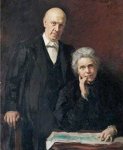
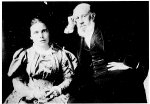 Samuel
Barnett, the vicar of St Jude Whitechapel, and his wife
Henrietta [left at the time of their wedding, right in later life; see here for their memorial in Westminster Abbey], were closely involved in the project,
along with Octavia
Hill, Osborne Jay,
Charles Booth and other housing reformers who were also supporters of
the nascent Charity Organisation Society (COS), which helped distribute its
prospectus. It was to be run on 'Octavian' lines. The
EEDC minutes show that they deplored the values and behaviour of the
poor (Booth was one of the few who from the start took a different line), but felt a deep compassion for
their needs, a desire to provide help and friendship, and a frustration
with
the Metropolitan Board of Works' slowness in slum clearance. Barnett had written
despairingly in 1881 My hope of one
day having a parish with houses fit for decent people has grown very
faint.
Samuel
Barnett, the vicar of St Jude Whitechapel, and his wife
Henrietta [left at the time of their wedding, right in later life; see here for their memorial in Westminster Abbey], were closely involved in the project,
along with Octavia
Hill, Osborne Jay,
Charles Booth and other housing reformers who were also supporters of
the nascent Charity Organisation Society (COS), which helped distribute its
prospectus. It was to be run on 'Octavian' lines. The
EEDC minutes show that they deplored the values and behaviour of the
poor (Booth was one of the few who from the start took a different line), but felt a deep compassion for
their needs, a desire to provide help and friendship, and a frustration
with
the Metropolitan Board of Works' slowness in slum clearance. Barnett had written
despairingly in 1881 My hope of one
day having a parish with houses fit for decent people has grown very
faint.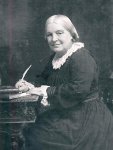
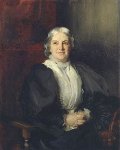
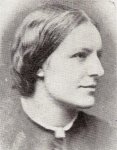 Octavia Hill (1838-1912) [right in the 1880s, in John Singer Sargent's 1989 painting in the National Portrait Gallery and in her latter years] had
been working since 1865, with John Ruskin's backing, as a rent
collector. By 1874 she and her trained team of female volunteers were
responsible for fifteen housing schemes, both old and new properties,
around London. Her ideal was that a 'sympathetic lady collector'
(rather than a landlord's clerk) could inspire and educate tenants to
transform their lives: they would come to love her and be shamed into
better ways. Drawing on Ruskin's rustic idyllism, she argued that they
were to be queens ... each in her own domain, taking control as they would of her own house, garden or field. Whitewash
and new window panes were seen as a reward; she regarded communal
facilities (sinks, taps and lavatories) on each landing as sufficient
for tenants who could not be trusted to use them properly. In other
words, she was a benevolent despot who tended to infantilise the tenants - and was not prepared for the
conflicts that ensued when the collector's authority was not recognised. Indeed it was rather the reverse: as Beatrice Webb said,
some referred proprietorially to 'my woman collector', whereas a
friendly neighbour was 'the lady next door.' 13 August 2012 was
the centenary of Octvaia Hill's death, and various events were held to mark it.
Octavia Hill (1838-1912) [right in the 1880s, in John Singer Sargent's 1989 painting in the National Portrait Gallery and in her latter years] had
been working since 1865, with John Ruskin's backing, as a rent
collector. By 1874 she and her trained team of female volunteers were
responsible for fifteen housing schemes, both old and new properties,
around London. Her ideal was that a 'sympathetic lady collector'
(rather than a landlord's clerk) could inspire and educate tenants to
transform their lives: they would come to love her and be shamed into
better ways. Drawing on Ruskin's rustic idyllism, she argued that they
were to be queens ... each in her own domain, taking control as they would of her own house, garden or field. Whitewash
and new window panes were seen as a reward; she regarded communal
facilities (sinks, taps and lavatories) on each landing as sufficient
for tenants who could not be trusted to use them properly. In other
words, she was a benevolent despot who tended to infantilise the tenants - and was not prepared for the
conflicts that ensued when the collector's authority was not recognised. Indeed it was rather the reverse: as Beatrice Webb said,
some referred proprietorially to 'my woman collector', whereas a
friendly neighbour was 'the lady next door.' 13 August 2012 was
the centenary of Octvaia Hill's death, and various events were held to mark it.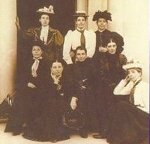 Katharine Buildings
(the last syllable usually pronounced 'ine' as in 'wine', rather than 'in' as in 'gin') was named, not
for St Katharine's Docks,
but for Kate Potter Courtney, wife of Leonard
Courtney MP [Potter sisters left - see below for Beatrice]. The Master
of the Royal Mint had decreed that the originally-proposed name of
'Royal Mint Buildings' was objectionable.
Katharine Buildings
(the last syllable usually pronounced 'ine' as in 'wine', rather than 'in' as in 'gin') was named, not
for St Katharine's Docks,
but for Kate Potter Courtney, wife of Leonard
Courtney MP [Potter sisters left - see below for Beatrice]. The Master
of the Royal Mint had decreed that the originally-proposed name of
'Royal Mint Buildings' was objectionable. 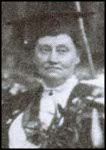 Margaret Wynne Nevinson,
daughter of a Leicester clergyman and an early visitor/rent collector, despaired
of the lack of homemaking
skills, which she believed was was not just
the result of poverty (she made comparison with the French and German
poor, who, she said, had better culinary and dietary
knowledge). Tenants, she said, regarded cereal foods as 'work'us
stuff'; their staples were stewed tea, bread and butter, fried steak,
liver and lights. Most
of the mothers had worked in pickle or jam factories, and knew
nothing of housekeeping. Their ill-nourished husbands pardonably took
to drink, and the unfortunate babies, brought up on strong tea, sips
of beer and gin, stuffed with adulterated sweets, tempted with whelks
and winkles, died quickly ... a few men, who had the foresight to
marry domestic servants, had their food properly cooked and their
homes kept clean.
Margaret Wynne Nevinson,
daughter of a Leicester clergyman and an early visitor/rent collector, despaired
of the lack of homemaking
skills, which she believed was was not just
the result of poverty (she made comparison with the French and German
poor, who, she said, had better culinary and dietary
knowledge). Tenants, she said, regarded cereal foods as 'work'us
stuff'; their staples were stewed tea, bread and butter, fried steak,
liver and lights. Most
of the mothers had worked in pickle or jam factories, and knew
nothing of housekeeping. Their ill-nourished husbands pardonably took
to drink, and the unfortunate babies, brought up on strong tea, sips
of beer and gin, stuffed with adulterated sweets, tempted with whelks
and winkles, died quickly ... a few men, who had the foresight to
marry domestic servants, had their food properly cooked and their
homes kept clean. 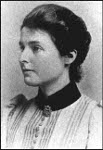 Beatrice Potter [right] was the younger sister of Kate Potter Courtney,
who after her marriage to Sidney became Beatrice Webb,
and was a founder of the
London School of Economics, where the Katharine Buildings ledgers are
now housed. Her diaries record that she was initially rather depressed by the bigness of the work that she took up in 1885 - When
I look at all those long balconies and think of all the queer
characters - occupants and would-be occupants and realize that the
characters of the community will depend on our personal power ... I
feel rather dizzy. She notoriously spoke of the aborigines
of the East End - a view which she later modified!
Beatrice Potter [right] was the younger sister of Kate Potter Courtney,
who after her marriage to Sidney became Beatrice Webb,
and was a founder of the
London School of Economics, where the Katharine Buildings ledgers are
now housed. Her diaries record that she was initially rather depressed by the bigness of the work that she took up in 1885 - When
I look at all those long balconies and think of all the queer
characters - occupants and would-be occupants and realize that the
characters of the community will depend on our personal power ... I
feel rather dizzy. She notoriously spoke of the aborigines
of the East End - a view which she later modified!  Beatrice,
while she still tramped the streets taking up references, became less
involved in the daily running, increasingly concentrating on
observation and social research, using Octavia Hill's system, and
focusing on the structural basis of poverty. Henrietta Barnett
described her as plunging fearlessly
[into the Whitechapel slums] in
her search for facts, working in sweating shops [masquerading
as a poor Jewish seamstress] and
living as a lone girl in block buildings. However, the social
statistician Herbert Spencer was critical of his protégée for
'slumming' in this way: Bear in
mind that the
experiences which you thus gain are misleading experiences; for what
you think and feel under such conditions are unlike what is felt and
thought by those whose experiences you would describe
- in other words, she was blurring the line between participant and
observer, fact and fantasy, and this did not help the emerging
discipline of sociology. Beatrice herself later dismissed her
activities as a
lark. Her
painful apprenticeship in the East End convinced her that individual
casework
could not reform the working poor. In her diary for November 1886 she
wrote, of Katharine Buildings, The
respectable
tenants keep rigidly to
themselves. The meeting places - there is something grotesquely coarse
in this - are the water-closets. Boys and girls crowded in these
landings - they are the only lighted place in the buildings - to gamble
and flirt. The lady collectors are an altogether superficial
thing. Undoubtedly their gentleness and kindness bring light into
many homes - but what are they in face of this collected brutality?
Beatrice,
while she still tramped the streets taking up references, became less
involved in the daily running, increasingly concentrating on
observation and social research, using Octavia Hill's system, and
focusing on the structural basis of poverty. Henrietta Barnett
described her as plunging fearlessly
[into the Whitechapel slums] in
her search for facts, working in sweating shops [masquerading
as a poor Jewish seamstress] and
living as a lone girl in block buildings. However, the social
statistician Herbert Spencer was critical of his protégée for
'slumming' in this way: Bear in
mind that the
experiences which you thus gain are misleading experiences; for what
you think and feel under such conditions are unlike what is felt and
thought by those whose experiences you would describe
- in other words, she was blurring the line between participant and
observer, fact and fantasy, and this did not help the emerging
discipline of sociology. Beatrice herself later dismissed her
activities as a
lark. Her
painful apprenticeship in the East End convinced her that individual
casework
could not reform the working poor. In her diary for November 1886 she
wrote, of Katharine Buildings, The
respectable
tenants keep rigidly to
themselves. The meeting places - there is something grotesquely coarse
in this - are the water-closets. Boys and girls crowded in these
landings - they are the only lighted place in the buildings - to gamble
and flirt. The lady collectors are an altogether superficial
thing. Undoubtedly their gentleness and kindness bring light into
many homes - but what are they in face of this collected brutality?| No.97 taken with No. 98 Nov. 1885 - May 1886 Ella Pycroft Rent Collector of K. Buildings Beatrice Potter ditto shares the two rooms. Ella Pycroft b. Devonshire, daughter of physician (single woman). Came to London 1883 in search of work. B. Potter, daugther of timber merchant, born in Gloucestershire, parents North Country. Came to London for family reasons and with hope fo work (single woman) ... In religious opinions they are doubtful and differing. Energetic and punctual in professional duties - not absolutely accurate in accounts. B.P. especially deficient. E.P. takes the lead in management. B.P. in observation. Both of them are professionally ambitious. |
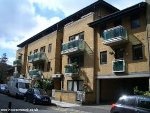 Between 1957 and 1962 the late Professor Peter Townsend gathered
information
from current residents, some of them descendents of the original
tenants; his unpublished
research is archived at Essex University. In
1970 Tower Hamlets registered title to flats 1-263 with the Land
Registry, but the block was demolished later in that decade, and
replaced with more up-to-date social housing. Right
is an example of commercial housing in Cartwright Street - St Mary
Grace's Court, named after the Cistertian abbey that once stood nearby.
Between 1957 and 1962 the late Professor Peter Townsend gathered
information
from current residents, some of them descendents of the original
tenants; his unpublished
research is archived at Essex University. In
1970 Tower Hamlets registered title to flats 1-263 with the Land
Registry, but the block was demolished later in that decade, and
replaced with more up-to-date social housing. Right
is an example of commercial housing in Cartwright Street - St Mary
Grace's Court, named after the Cistertian abbey that once stood nearby.Back to History page